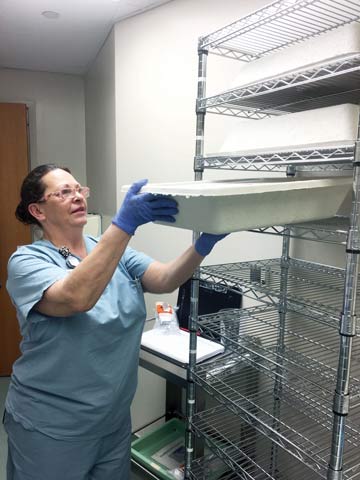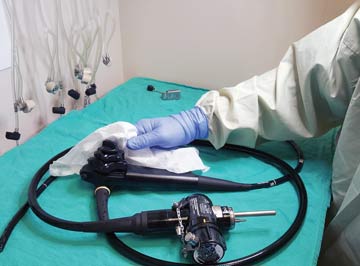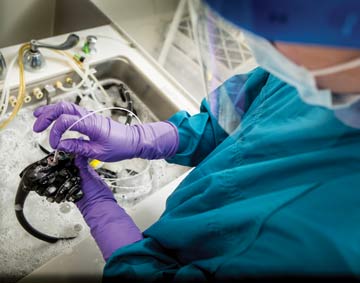After bedside cleaning, contaminated scopes should be placed in a closed bag or container for transport to the reprocessing room, where they're hooked up to an automated leak tester. Leak tests detect damage to the external surface of the scope,
as well as the internal channels. Imperfections, no matter how small, can lead to inadequate disinfection and even further damage to the scope.
The leak test is a crucial step in the reprocessing process, according to Joyce Mackler, RN, MSN, CASC, nurse manager at the Seaford (Del.) Endoscopy Center. "Don't rush through it," she says, "and be sure to observe the scope in clean water for
at least 30 seconds while angulating the bending sections of a scope in all directions."
After the scope has passed the leak check, brush its internal channels twice with properly sized brushes. "We then connect it to a machine that flushes the channels with enzymatic soap for one minute, and then brush the scope one more time," says
Mr. Gonzales. He reconnects the scope to the flushing machine, which flushes its channels with clean water. The outside of the scope is also wiped down with clean water.
"Don't forget to take ample time cleaning the reusable button and biopsy valves," warns Ms. Mackler. "You have to use a small brush to clean all the crevices and holes and depress the air-water valve to clean the concealed hole."
Don't skip any of the steps and don't go through the motions.
— Jorge Tavera, CGTS
After manual cleaning, Mr. Tavera says it's important to check the outside of the scope with a 10x magnifing glass to inspect for residual soil. Be sure you take the time to inspect the tip of the scope where bacteria often hide, adds Mr. Tavera.
You can also use a boroscope to examine internal channels. Visual inspection provides added assurance that the scope and its accessories are clean and free from contamination.
Scopes that are deemed to be clean can be placed in an automated endoscope reprocessor (AER). Unclean scopes neeed to be manually brushed and flushed again.
An important point: Avoid letting endoscopes sit for more than 60 minutes before cleaning. "Delays can lead to bioburden remaining on or in the scope, which increases cross-contamination and infection risks," says Mr. Tavera.
Mr. Czarnowski agrees it's critical to ensure scopes don't sit for long periods before being thoroughly cleaned. "Scope manufacturers have recently instituted delayed-processing protocols that not all scope owners know about," he explains. "Essentially,
the manufacturers say that if more than an hour passes between when the insertion tube is removed from the patient to the start of manual cleaning in decontamination, scopes must soak for an extended period before they can be high-level disinfected."
.svg?sfvrsn=be606e78_3)



.svg?sfvrsn=56b2f850_5)